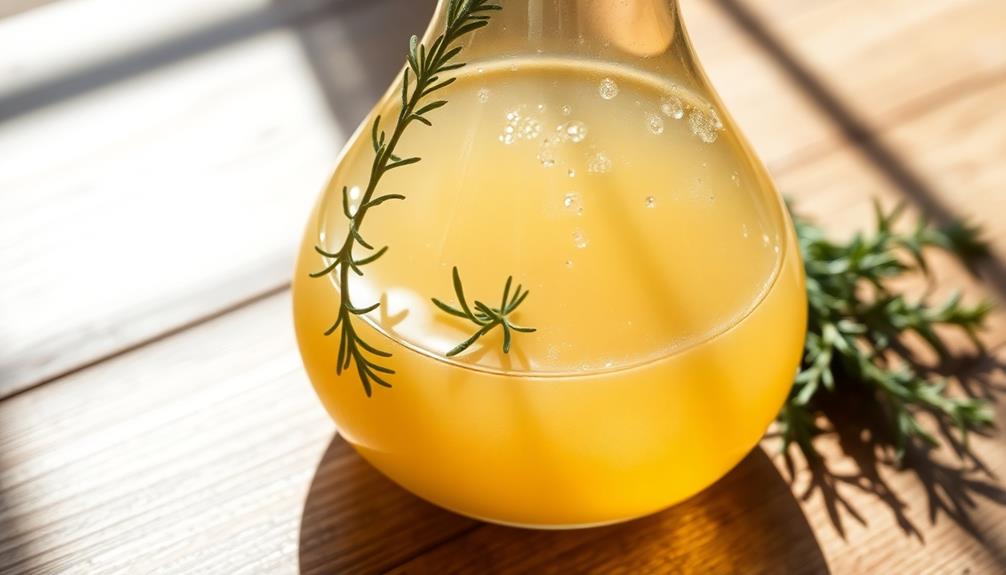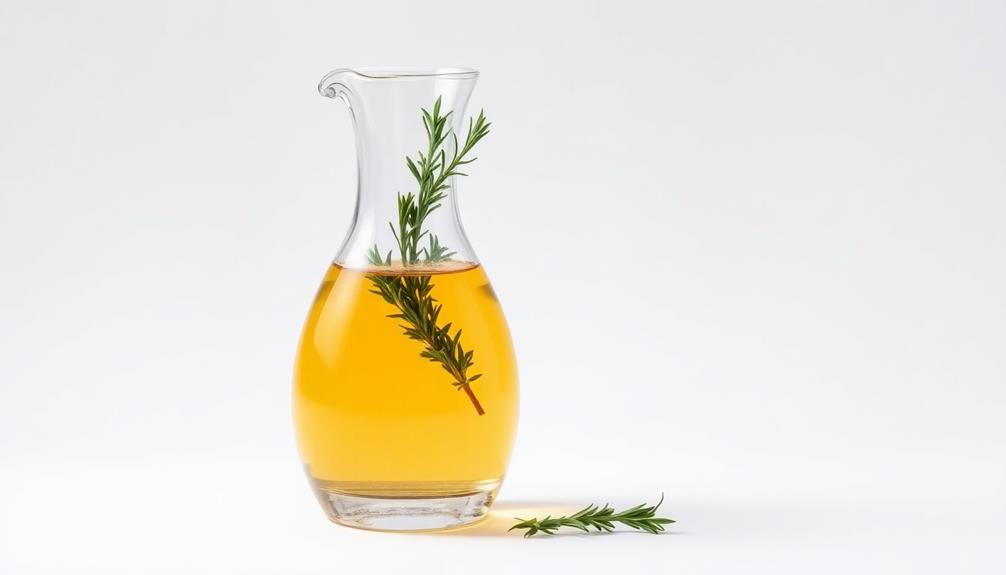Retsina, a captivating Greek wine, boasts a millennia-old history and a unique flavor profile that'll transport you to the sun-drenched vineyards of Greece. This distinctive white wine blends the aromatic notes of pine resin with a crisp, dry character, creating an unforgettable sensory experience. You'll detect bold, pine-like flavors that linger on your palate, complemented by natural, earthy aromas. Whether you're pairing it with traditional Greek cuisine or simply savoring it on its own, Retsina offers a taste of Greek culture that's sure to intrigue your senses. There's more to discover about this captivating wine style.
Key Takeaways
- Retsina is a traditional Greek wine with a distinctive pine-like flavor profile, dating back thousands of years to ancient Greek winemaking practices.
- The addition of Aleppo pine resin during the winemaking process gives Retsina its unique taste and aroma, which has become an integral part of Greek culture.
- Retsina is characterized by its bold, complex flavor and is often enjoyed chilled, pairing well with traditional Greek cuisine and offering a unique tasting experience.
- The winemaking process for Retsina involves carefully crushing and incorporating the pine resin into the wine must, allowing for fermentation and producing the signature taste.
- Retsina is gaining recognition among wine enthusiasts worldwide, as it offers a distinct and engaging sensory experience that reflects the sun-drenched vineyards of Greece.
History
The origins of retsina can be traced back to ancient Greece, where the practice of resinating wine dates back thousands of years.
Ancient Greeks would add tree resin, usually from the Aleppo pine, to their wine to help preserve it during long voyages. The resin also gave the wine a unique, distinctive flavor that many people grew to love.
Over time, retsina became an integral part of Greek culture and was enjoyed by people from all walks of life.
Today, retsina is still produced in Greece using traditional methods. The resin is carefully selected and added to the wine at just the right time to impart the perfect balance of flavors.
While the production process may have evolved slightly, the core essence of retsina remains the same – a delightful, aromatic wine that transports you back to the ancient Mediterranean world.
Whether sipped on a sunny terrace or paired with traditional Greek cuisine, retsina is a taste of history that continues to captivate wine enthusiasts around the world.
Recipe
Retsina is a unique Greek wine that features a distinct pine-like flavor. This flavor comes from the addition of resin, typically pine resin, during the winemaking process. While the exact origins of retsina are unclear, it has been produced in Greece for centuries and remains a beloved part of Greek culture and cuisine.
Retsina is often enjoyed as an aperitif or with traditional Greek dishes, particularly those that feature olive oil, lemon, and herbs. The resinous character of the wine can complement these flavors well, creating a harmonious dining experience.
Ingredients:
- 1 bottle of dry white wine
- 2-3 tablespoons of pine resin
- 1 lemon, zested
- 1 sprig of fresh rosemary (optional)
In a large saucepan, combine the white wine and pine resin. Bring the mixture to a gentle simmer over medium heat, stirring occasionally to ensure the resin fully dissolves.
Remove the pan from the heat and stir in the lemon zest. Allow the mixture to cool slightly, then transfer it to a clean glass bottle or carafe. If desired, add a sprig of fresh rosemary for additional aroma.
Refrigerate the retsina for at least 4 hours, or until thoroughly chilled, before serving.
When serving retsina, it's important to remember that the resinous flavor can be quite strong. Start with small pours and encourage your guests to sip and savor the wine, as its unique character may take some getting used to.
Retsina pairs well with simple, Mediterranean-inspired dishes, such as grilled fish, olives, and feta cheese. If you’re looking to elevate your meal, consider trying a traditional Greek dish like moussaka or a simple grilled lamb chops recipe. The refreshing pine and resin notes of Retsina complement the earthy flavors of the lamb, making it a perfect pairing. For a complete Mediterranean experience, finish off your meal with a plate of baklava or honey-drizzled figs.
Cooking Steps
First, crush some fresh Aleppo pine resin.
Then, add the crushed resin right to your wine and let it ferment.
Step 1. Crush Fresh Aleppo Pine Resin

Typically, you'll want to crush the fresh Aleppo pine resin using a mortar and pestle. The resin, with its distinctive piney aroma, will need a bit of elbow grease to break down into smaller pieces.
As you grind the resin, you'll notice it becomes sticky and pliable, almost like a natural chewing gum. Keep at it until you've reduced the resin to a fine, powdery texture. This process allows the resin to release its essential oils, which will later infuse the wine with that unique, aromatic flavor.
Be careful not to overdo the crushing, as you don't want to end up with a paste-like consistency. The goal is to create a coarse, granular resin that can easily be added to the wine must.
Once you've achieved the desired texture, you're ready to move on to the next step in the retsina-making process. Just remember to work slowly and steadily, and don't be afraid to take breaks if your arm starts to tire.
Step 2. Add Crushed Resin to Wine

Add the crushed Aleppo pine resin to the wine must, stirring it in thoroughly. Watch as the mixture turns a lovely amber hue, the resin's distinctive aroma filling the air. This traditional technique infuses the wine with a unique, pine-like flavor that's been enjoyed for centuries.
Gently swirl the wine, allowing the resin to fully incorporate. You'll notice the liquid thickening slightly as the resin's natural compounds bind with the wine. This process rounds out the flavor profile, creating a smooth, well-balanced retsina.
Be sure to taste the wine periodically, adjusting the resin amount to suit your personal preferences. A little goes a long way, so start with a small addition and gradually increase until you achieve the desired taste.
With some experimentation, you'll masterfully craft a retsina that tantalizes the senses.
Step 3. Allow Retsina to Ferment

With the resin fully incorporated, it's time to let the retsina ferment. This ancient Greek wine relies on this crucial step to unlock its signature flavor.
Pour the resin-infused must into clean fermentation vessels, making sure to leave a few inches of headspace at the top. The yeast will spring into action, converting the sugars into alcohol and carbon dioxide. Over the next few weeks, you'll hear the steady hiss of the fermentation process as the yeast works its magic.
Resist the temptation to peek too often – opening the vessels allows precious aromas to escape. Instead, let the retsina do its thing in a cool, dark spot.
The fermentation will naturally slow as the yeast consumes the available sugars. Once the bubbling subsides, your retsina is ready for the next step.
Carefully transfer the wine to clean vessels, leaving behind any sediment. With the fermentation complete, your retsina is one step closer to that iconic pine-infused flavor.
Step 4. Bottle and Store Retsina

Once the fermentation has completed, it's time to bottle your retsina. This is an exciting step as you get to see the fruits of your labor!
First, ensure your bottles and equipment are thoroughly cleaned and sanitized. This will help preserve the quality of your retsina. Gently pour or siphon the wine into the bottles, being careful not to disturb the sediment at the bottom of the fermentation vessel. Leave a bit of headspace at the top of each bottle.
Next, seal the bottles with your chosen closures, whether that's traditional corks, screw caps, or something else. Make sure the seals are tight to prevent air from entering and spoiling your retsina.
Now, it's time to store your bottled retsina. Find a cool, dark place like a cellar or basement that maintains a consistent temperature. Avoid areas with fluctuating temperatures or direct sunlight, as these can adversely affect the flavor and aroma of your retsina over time.
With proper bottling and storage, your homemade retsina should continue to age gracefully, developing complex flavors as the months and years go by.
Step 5. Serve Retsina Chilled

When ready to serve, chill your retsina to the perfect temperature.
You'll want to pop the bottle in the fridge for around 30 minutes. This'll bring the wine down to an ideal 45-50°F (7-10°C). Any colder and you'll mask the wonderful flavors.
Once thoroughly chilled, pour the retsina into your favorite wine glasses. You'll notice the pale golden hue and a light, refreshing fizz.
Take a deep breath – can you detect the earthy, pine-like aroma?
Now, take a sip. The crisp, tart flavors dance across your tongue, balanced by the subtle sweetness. As you swallow, the resinous finish lingers pleasantly.
Retsina is best enjoyed chilled and fresh, so don't let your glasses sit too long.
Grab some olives or feta and savor every last drop. The perfect pairing for a sunny afternoon or light evening meal.
Final Thoughts
Retsina, the resinated wine, has captivated wine enthusiasts worldwide for centuries. This unique and ancient Greek beverage has a fascinating story that deserves your attention. While the bold, pine-like flavor may not be for everyone, those who appreciate its complexity and history will find it a truly rewarding experience.
As you savor a glass of retsina, allow yourself to be transported to the sun-drenched vineyards of Greece. Imagine the gentle breeze carrying the scent of resin and the sound of cicadas humming in the distance. The resinous notes, derived from the addition of Aleppo pine resin, create a distinctive and unforgettable taste that lingers on the palate.
Whether you're new to retsina or a seasoned enthusiast, we encourage you to approach this unique wine with an open mind and a willingness to explore.
Embrace the cultural traditions and let the flavors of the past awaken your senses. Retsina is a legacy worth discovering and celebrating.
Frequently Asked Questions
What Is the Alcohol Content of Retsina?
The alcohol content of retsina typically ranges from 11% to 13% by volume. This resinated Greek wine has a distinctive pine-like flavor that comes from the resin added during the winemaking process.
How Long Does Retsina Wine Last After Opening?
Once you've opened that bottle of wine, it won't last forever. Typically, an opened bottle of retsina will stay fresh for around 3-5 days when stored properly in the refrigerator. Be sure to recork it tightly to preserve the flavor.
Where Can I Purchase Retsina Wine in My Area?
You can find retsina wine at your local liquor stores, specialty wine shops, or even some grocery stores that have a robust wine selection. Check with your nearest retailers to see if they carry this unique Greek wine.
How Should Retsina Wine Be Stored?
You should store retsina wine in a cool, dark place like a basement or wine cellar. Avoid exposing it to direct sunlight or fluctuating temperatures, as this can negatively impact the flavor and quality of the wine.
Is Retsina Wine Suitable for Vegans?
Yes, retsina wine is suitable for vegans. The resin used to create the distinctive flavor of retsina wine is derived from pine trees, which aligns with vegan dietary guidelines.










